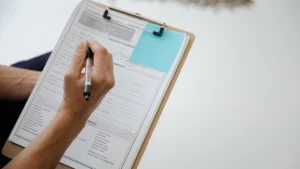If you often worry, feel nervous for no clear reason, or get overwhelmed in everyday situations, calming exercises for anxiety can help you feel more in control when your mind feels too busy or your body feels tense.
The good news is that there are exercises (from simple to complex) that you can do to calm your body and mind.
Learn how to notice the signs of anxiety, understand what it feels like, and try calming techniques that work.

What is Generalized Anxiety Disorder (GAD)?
Generalized Anxiety Disorder (GAD) is when you worry a lot – more than most people do – and it’s hard to stop. This kind of worry isn’t just about one thing. You might stress about work, money, family, health, or even small daily tasks. The worry is constant and often feels out of your control.
If you have GAD, you might feel nervous most of the time, even when nothing bad is happening. It’s not just “being anxious” once in a while; it’s a feeling that follows you around for months or even years.
It’s important to know that GAD is common. But there are ways to manage it, and many people with GAD learn how to feel better with the right tools and support.
Identifying Characteristics of Individuals with GAD
Before exploring effective Calming Exercises for Anxiety, it’s important to understand the common symptoms experienced by individuals with Generalized Anxiety Disorder (GAD), as identified in scientific research.¹ ² ³
Emotional Symptoms
You may experience excessive and uncontrollable worry about various aspects of life, such as work, health, or daily responsibilities. This persistent worry can lead to feelings of restlessness, irritability, and difficulty concentrating. These emotional symptoms are characteristic of GAD and have been documented in clinical studies.
Behavioral Symptoms
GAD can affect your behavior, leading to difficulties in managing daily tasks. You might find it challenging to concentrate, experience fatigue easily, and have trouble sleeping. These behavioral patterns are often observed in individuals with GAD.
Physical Symptoms
Physically, GAD can manifest in various ways. You might experience muscle tension, headaches, or gastrointestinal issues like nausea. Also, symptoms such as a racing heart or sweating are common. These physical manifestations are linked to the body’s response to chronic anxiety and have been reported in medical literature.
Why Soothing Strategies Matter for Long-Term Anxiety Relief
When anxiety takes over, your body and mind shift into a kind of “emergency mode”—your heart races, muscles tense, and thoughts spiral. It’s a difficult state to navigate, but that’s where Calming Exercises for Anxiety can make a meaningful difference. These exercises not only help ground you in the moment but also train your body to recover more quickly from anxious episodes over time. With consistent practice, managing stress becomes more intuitive, even in challenging situations. Let’s explore a few techniques that can help you regain control and feel more at ease.
Simple Anxiety-Calming Exercises to Try Anytime
Let’s go over some simple calming exercises you can try anytime and anywhere you feel anxious. You don’t need special tools or a lot of time – just a quiet moment to pause and help your mind and body settle down. These exercises can be really helpful when your thoughts are racing or when you feel like panic is starting to creep in.
1. Square Breathing (Box Breathing)
This is a breathing technique that helps slow down your heart rate and calm your nervous system. Here’s how to do it:
- Breathe in for 4 seconds
- Hold your breath for 4 seconds
- Breathe out for 4 seconds
- Hold again for 4 seconds
Keep repeating this pattern. Imagine drawing a square in your mind—each side of the square matches each step of the breath. This method helps bring your attention away from anxious thoughts and back to your breath.
2. Mindfulness Exercise: The 5-4-3-2-1 Grounding Technique
The University of Rochester Medical Center published a five-step exercise that helps ground you in the present moment when your anxiety makes your mind bounce around. Try it slowly and breathe deeply as you go:
- 5 things you can SEE – Look around and name five things. It could be a lamp, a picture, or even your hands.
- 4 things you can TOUCH – Feel something with your fingers, like your clothes, your chair, or your phone.
- 3 things you can HEAR – Listen for sounds: a fan, birds outside, or the hum of your computer.
- 2 things you can SMELL – Sniff the air or something nearby, like a candle, soap, or the smell of outside air.
- 1 thing you can TASTE – Notice the taste in your mouth. Maybe it’s gum, toothpaste, or leftover coffee.
This helps pull your mind out of fear and brings it back to the now.
3. Progressive Muscle Relaxation (PMR)
This helps you relax your body and release tension. You do it by slowly tensing and then relaxing different muscle groups. Here’s how:
- Start with your feet. Tense the muscles (like you’re trying to grip the floor with your toes). Hold for 5 seconds, then relax for 30 seconds.
- Move up your body—legs, stomach, hands, arms, shoulders, neck, face.
- Notice the difference between how your body feels when it’s tense versus when it’s relaxed.
This teaches your body how to “let go” of physical tension and gives your brain a signal to calm down, too.
Try these techniques one at a time, or mix them depending on what works best for you. Practice makes it easier, so the more you use them even when you’re just a little anxious, the more natural it will feel when anxiety gets strong.
Moderate Calming Techniques for Anxiety
These exercises are not just for when you’re in a panic. They help train your mind and body to stay calm more often, even in stressful situations. That’s what we mean by building long-term resilience.
1. Journaling Your Thoughts
Writing things down helps you get the worries out of your head. You don’t need to be a great writer; just be honest. Write about what made you anxious, how you felt, and what helped. Over time, you’ll start to see patterns and learn more about what calms you. That builds self-awareness, which is a big part of resilience.
- At the end of the day, write down 3 things that made you feel stressed.
- Then write 1 thing that made you feel calm or happy, even something small.
2. Yoga or Gentle Stretching
You don’t need to be super flexible or go to a fancy class. Even 10–15 minutes of slow movement and deep breathing helps release tension and calm your nervous system. It also teaches you to focus on your body instead of your anxious thoughts.
- Start with some deep breaths.
- Slowly stretch your arms, neck, shoulders, and legs.
- Move gently and breathe deeply as you go.
3. Daily Meditation or Quiet Time to Calm Your Anxiety
You don’t need to “clear your mind” completely. Just sit quietly for a few minutes, focus on your breathing, and gently bring your attention back if it wanders. Even 5 minutes a day helps train your brain to pause before reacting to stress.
- Find a quiet spot.
- Close your eyes and breathe in slowly through your nose and out through your mouth.
- When your thoughts drift, bring your focus back to your breath.
4. Body Scan Relaxation
This is a way to check in with your body and release any tension you might not even realize you’re holding. Start at your toes and slowly work your way up, noticing how each body part feels.
- Lie down or sit comfortably.
- Slowly bring your focus to your feet, then legs, back, shoulders, arms, neck, and head.
- As you notice tension, gently relax that area.
These techniques may not feel “instant” like deep breathing or grounding exercises, but over time, they rewire your brain to feel safer and more balanced.
Advanced Calming Practices for Structured Routines
If you’ve already tried simple and moderate calming techniques and want something deeper, these are for you. They help you create a routine, which is something you do regularly that trains your body and brain to keep calm. The more consistent you are, the more natural it becomes to manage stress.
1. Guided Meditation Programs
This is a step up from basic quiet-time meditation. You follow a recorded voice (or an app) that walks you through what to focus on, like your breath, your body, or calming thoughts. Many programs are made to help with anxiety, stress, or even sleep.
- Set aside 10–20 minutes each day.
- Use a trusted app or audio guide.
- Sit or lie in a comfortable place and follow the voice.
- Don’t worry if your mind wanders; just gently bring it back.
Doing this regularly can lower anxiety and help your brain handle stress more calmly.
2. Regular Mindful Movement (like Tai Chi or Flow Yoga)
Tai Chi and flow-style yoga are slow, mindful forms of movement. They combine body control, deep breathing, and focus. These practices have been shown to help lower anxiety and improve how you react to stress.
- Find a class (in person or online) that teaches slow, mindful movement.
- Practice 2–3 times a week.
- Focus on your breath and how your body feels during each movement.
- Let go of judgment. It’s about feeling calm, not getting it perfect.
3. Structured Breathwork Sessions
This isn’t just deep breathing. It’s a set of breathing techniques done in a planned session, often for 10–30 minutes. Some people use specific breath patterns to relax, like alternate-nostril breathing, 4-7-8 breathing, or coherent breathing (breathing in for 6 seconds and out for 6 seconds).
- Schedule a few breathwork sessions each week.
- Use a timer or app that guides your breath.
- Sit in a quiet place with your back straight and eyes closed.
- Let your breath set the rhythm for your calm.
4. Create a Calming Routine You Follow Daily
You can build your calming ritual – something you do at the same time every day that sends a message to your body: It’s time to relax.
Your routine could include:
- A short breathing exercise
- Journaling your feelings
- A cup of tea in silence
- Reading something peaceful before bed
- A body scan or light stretching
Doing the same calming actions daily helps your brain feel safe and steady. It becomes a habit, like brushing your teeth, but for your mind.
When to Seek Professional Help for GAD
Sometimes, calming exercises and self-care help a lot, but they might not be enough on their own. If you’re still feeling anxious most days, even after trying different techniques, it may be time to talk to a professional.
Signs You Should Ask for Help With Anxiety
Here are some signs that it’s time to reach out for support:
- You feel anxious almost every day, and it’s hard to control.
- Your worry gets in the way of school, work, sleep, or relationships.
- You often feel restless, on edge, or easily tired.
- You notice physical symptoms like a racing heart, headaches, stomach aches, or trouble sleeping.
- You’ve stopped doing things you enjoy because of your anxiety.
- You’ve tried calming exercises, but you still feel overwhelmed.
How a Mental Health Professional Can Help With Calming Exercises
A trained therapist or counselor can help you understand what’s going on and teach you tools that go deeper than what you can do on your own. They might use special therapies like CBT (Cognitive Behavioral Therapy), which is proven to help people with GAD.
A holistic approach (yoga, meditation, and outdoor therapy) is also beneficial. A mental health professional can talk to you about whether that’s right for you.
Asking for help doesn’t mean you’ve failed; it means you care about your health and want to feel better. You deserve support.
And remember: OceanRock Health is here for you. If you’re dealing with anxiety and want more support, including help with calming exercises for anxiety, our team is ready to guide you.

Sources:
- Rowa, K., Waechter, S., Hood, H. K., & Antony, M. M. (2017). Generalized Anxiety Disorder. Psychopathology, 149–186. https://doi.org/10.1002/9781394258949.ch4
- Thayer, J. F., Friedman, B. H., & Borkovec, T. D. (1996). Autonomic characteristics of generalized anxiety disorder and worry. Biological Psychiatry, 39(4), 255–266. https://doi.org/10.1016/0006-3223(95)00136-0
- Generalized anxiety disorder: Overview. (2017, October 19). Nih.gov; Institute for Quality and Efficiency in Health Care (IQWiG). https://www.ncbi.nlm.nih.gov/books/NBK279595/









